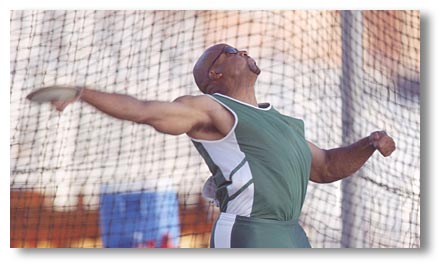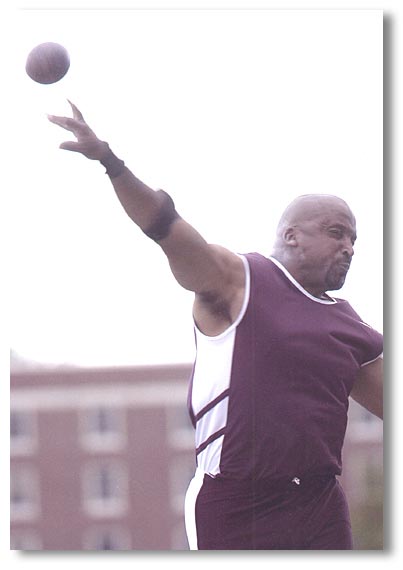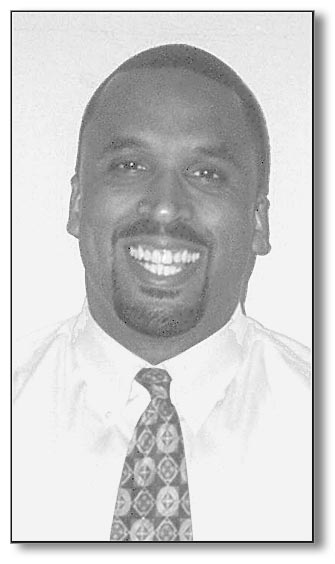 |
||
| Posted February 23, 2003 | ||
 Monty Rand photo
Monty Rand photo
If Glenn Thompson can throw the discus 175-0 (a recent best) as a 40-year-old, he'll be ranked in the top two or three in the world this year. Thompson can put, too. In 1999, his 61-3 with the 16-pound ball at the USATF Masters indoor nationals in Boston qualified him for the USATF outdoor open nationals in Eugene, Oregon -- coincidentally the site of the2003 masters nationals. With a wife, a daughter, a dog and a cat -- besides a magazine and a Web site -- Thompson has plenty on his plate -- and much to be proud of. And he'll have plenty more to smile about as an M40 thrower for the first time this season.
|
Strong
advocate of the throws: Glenn Thompson needs every centimeter of his broad shoulders. Besides supporting a family of three in Harrisburg, Pennsylvania, he holds down a full-time job as a business analyst for Highmark Blue Cross Blue Shield (14 years with the company) and publishes the Long & Strong Throwers Journal and the Web site that inspired it. And did we mention heís a world-class masters thrower? As it turns out, he just turned 40 (on Feb. 16, 2003), and heís raring to go in his new age group. Born in Philadelphia, Glenn attended Wissahickon High School in Ambler, Pennsylvania, and Shippensburg University. His best high school marks were 54-2 (shot) and 165-10 (discus). In college, he threw 55-7 and 163-0. But he really let loose in submasters competitions, throwing 61-3 and 175-0. Now 6-foot-2 and 230 pounds, he hopes to make further breakthroughs in M40. This interview was conducted in January 2003. By Ken
Stone Masterstrack.com: So do you throw heavy things around the home? Are you dangerous in the garage? Thompson: I throw some iron around in the basement, but other than that, Iím pretty harmless in domestic settings. After all these years supporting masters, you finally became one this year. How excited are you? What are your goals? In my book, Iíve been a master since turning 30. The cool thing about being 30 was I had more meets I could participate in, and they are hard to come by as a post-collegiate. As for goals, I am not giving in to age kindly. I had two discus PRs last summer and was in good enough shape to do the same in the shot, but the technique was inconsistent. I recently dropped close to 30 pounds getting ready for my 40th. When I stand a certain way, and the lights hit just right, I can see an ab, maybe two! Every year is about PRs and throwing farther than before. I absolutely, positively refuse to age, and my performances provide some self-validation. How did you come to start your Web site and magazine? How much traffic does the site get? A year ago your magazine had about 500 subscribers. Whatís the number now? Are you breaking even financially? Thanks for asking, as this is one of my true passions. The Web site started as I was recovering from shoulder surgery back in the fall of í97. I was new to the Web and wanted to contribute something to throwing, so I started doing interviews online. I got some good feedback and really enjoyed doing it. The next spring I was in Boston with the crew from Long & Strong when they suggested I start a magazine. At this time Tom Kolheppís USA Thrower was on its last legs and Max Jonesí British Thrower was not publishing. I always enjoyed writing, and saw an opportunity to present a professionally done periodical with substantial and original content, something that was often missing from USA Thrower. The guys laugh recalling that moment when they could see the wheels turning and the light bulb on top of my head. At the time I thought LSTJ would be huge. I dreamed of quitting my job and devoting myself to this cause. After about a year, I realized that would not materialize. This is a niche publication that will grow some with time. I have a hardcore group of subscribers that have stuck with me from the beginning and others that have joined along the way. Currently I have close to 700 subscribers, and I am grateful for each and every one of them. I donít currently track hits on the Web site. This has been more of a marketing than a literary challenge. The battle is to get the word out there and let people know LSTJ exists, and then pique their interest. I was marginally in the black financially last year, thankfully. Whatever I make gets funneled back in because if youíre not growing, youíre dying in this business. Masters throwers are an interesting subset. As one of the traveling tribes, they seem to be tighter and more supportive than masters competitors in other events. Why is that? Relative to tribes, I think throwers think of themselves as a minority in the world of track and field, and that is at the core of that bond. We have a common culture that unites us, and have goals that we fight to achieve. There are egos sometimes, but for the most part we are very supportive while competing and push each other. Most of my favorite people are throwers. It is one of the few circles that I travel in that I feel is colorblind; weíre all throwers. We have some great laughs as well, mostly at the expense of each other. I look forward to being on the local and national circuit each year, renewing acquaintances. Many masters sometimes gravitate to throws after their running careers end (because of injury or whatever). Len Olson is one example. How hard is it for runners and jumpers to become good throwers? Craig Shumaker (M50 SP, multiple national masters championships) is probably the best former runner that I know of. That is because he was a sprinter and has the explosive qualities that you look for in a thrower. Distance runners typically wouldnít convert well to the throws, because of a lack of speed rather than small stature. In your revealing interview with Al Oerter in your January 2002 issue, the four-time Olympic discus champ said he had started out as a high school sprinter and then became a miler! At the end of your chat, he expressed interest in making another masters foray (in the discus, of course). Whatís the latest word from Al? Any chance weíll see him in Eugene this summer? I havenít had much contact with Al since that interview, but he didnít seem to have any interest in picking up the platter again. He seemed to be content with his life at that point. I believe he has some minor health concerns and perhaps that could be a factor as well. Your long and strong commandments include: ďThou shalt NOT do STEROIDS!!! Say no more!Ē Say a little more. Are masters obeying? I canít speak for foreign masters as I havenít competed against them. However, I would say here in the U.S. this is not an issue. There are outstanding throwers who succeed because of their commitment to throwing and God-given talent. I think you can look at some of the guys and tell they need some íroids, or at least some Ripped Fuel or SlimFast! Even with your edict against steroids, many masters require ďbannedĒ substances for quality-of-life medical issues. Should IAAF doping rules for open athletes be applied to masters as well? Such a fine line there. If you need XYZ to live a reasonably normal life, then Iím not too worried about competing against you. Besides, that medal doesnít validate who I am. I compete against the tape measure. If I PR and finish dead last, Iím buying drinks for everyone that kicked my behind! You sometimes call yourself Minister of Propaganda. If you were King of Masters Track as well, how would you improve its marketing? Marketing in my mind would mean drawing new members, as we arenít exactly what Madison Avenue is looking to for its next wave of pitchmen. However, I think we can explore finding new sponsors for masters track. There are a whole slew of products that appeal to our demographics, and those corporations should be approached. And no, Iím not speaking of Depends! In discussing your own meet in Pennsylvania Ė the Long and Strong Throwers Classic, begun in 2000 -- you once wrote: ďI am a big advocate of helping yourself rather than waiting around for someone to hand you something.Ē An admirable sentiment. But how could USATF Masters help your meet and masters throwers in general? You hit the nail on the head. Sometimes life sucks -- get over it and do something about it. As throwers, the deck is somewhat stacked against us in terms of exposure and financial support. Yes, we can complain to the high heavens and it is important to be heard. But donít say a damned word unless youíre willing to get off youíre a-- and do something to help yourself. Being African-American, I could scream ďracismĒ every time I donít get a break. Iíd rather make my own way rather than wait for George Bush or someone else to hand me something. The throwing community has talent, leadership and creativity. We need to organize and mobilize ourselves, before asking for handouts. That is what the Long and Strong Throwers Classic, and the Long and Strong Throwers Club is all about. I started the magazine along that same vein and Iím very proud of the efforts of my fellow club members in strengthening throwing. Shot and discus weights have pretty much stayed the same over the years for masters, but javelins have been a can of worms Ė with weights ranging from 400 to 800 grams and all sorts of specs. Whatís your take in the confusing masters jav dimension changes and rules? I have to admit that I am no javelin aficionado. But canít we just settle on weights and specifications by age class and stick with them? I get confused with who throws what. In 1999, you set a shot PR of 61-3 at the USATF Masters indoors championships that allowed you to enter that yearís national open championships, where you took 15th at the age of 36. How did the younger throwers react to you? Any interesting exchanges with the Godinas, Blooms, Nelsons, etc.? This was no doubt the highlight of my throwing career. And to have qualified in Boston in front of so many of my throwing friends was very special. Once in Eugene, the reception was warm from those who knew of my story. I was something of a curiosity to some, as to how I managed to PR at that age. Some coaches commented that I was too skinny ( at 250 pounds) to have thrown that far. This was a year before Adam Nelson and his big breakthrough, and I had a chance to have dinner with him and Bob Weir and Mike Buncic just off campus at Ken Spragueís house. Adam is a great guy and good for the sport and we had a good conversation that night. And Andy Bloom is always friendly -- another great ambassador for the sport. Your throwing club welcomes all ages Ė not just masters. Whoís the oldest and whoís the youngest member? Are masters doing themselves a disservice by segregating themselves at meets Ė only throwing among their older friends? I think my daughter is the youngest member at 14. We have a member who is 80 years old and full of life. And we run the gamut in between. In 2002, we opened the LSTC to anyone who wanted to join and had over 50 join us last year. As throwers, we certainly canít afford to segregate. We need to work together at all levels. Competitively, yes, we need different strata. However, we should try to be as inclusive as possible in our efforts. It seems that hammer throwers have a lock on USATF Masters leadership Ė with Ken Weinbel and George Mathews being the past two USATF Masters chairmen. How are these gents doing, in your opinion? Given your record of activism and hard work, would you be interested in running for masters office yourself? Hammer throwers are more analytical by nature, I think! I am very thankful for Ken and Georgeís efforts as well as Suzy Hess. Not all of us have the aptitude for politics and administration. Their efforts along with other throwers keep us as a group in the loop. These are people who have been very successful in their private lives and we are fortunate enough to have them donating their skills to our great sport. Ken, George and Suzy have been very supportive of my publishing efforts as well. (Iím buttering up Suzy because I think sheís a sharp lady. Ken and George donít affect me that way!) Perhaps some day I might have an interest in that, but I think Iím more of a worker bee than a politico. Iím constantly finding errors or omissions in masters throwing records. Are you satisfied that USATF and WMA have a solid set of masters age-group records? Are you aware of any age-group records that arenít getting proper recognition? Canít say that I am knowledgeable on this matter. There are so many records, I canít imagine keeping track of them. Personally, Iíve heard very little discussion amongst throwers on the validity of records. Masters are constantly pushing the envelope Ė having run a sub-4 mile and clearing 7 feet in the high jump. Brian Oldfield threw 70 feet at age 40 and Oerter threw 227-11 at age 43. What other major barriers could fall? I think the major barriers are at age 50. If you can mix an elite-level athlete who stays healthy and maintains their passion, they could go absolutely crazy with the lighter implements. Whoís the best masters throw right now? Lad Pataki? Tough question. Could be Lad because of his mastery of three events. Tom Gage is also very good across three events. Carol Finsrud had been head and shoulders above the competition for years, but Neni Lewis is setting records nearly every time out. There are a host of great throwers, and I donít mean to exclude any of them. There are a number of great javelin throwers also. Whatís your dream for masters track? I think itís all about participation. I think if we can keep more submasters involved, the sport will grow as they age. This is tough when family and career are at critical points. Many athletes donít know about the competitive options USATF presents. | |
|
|


